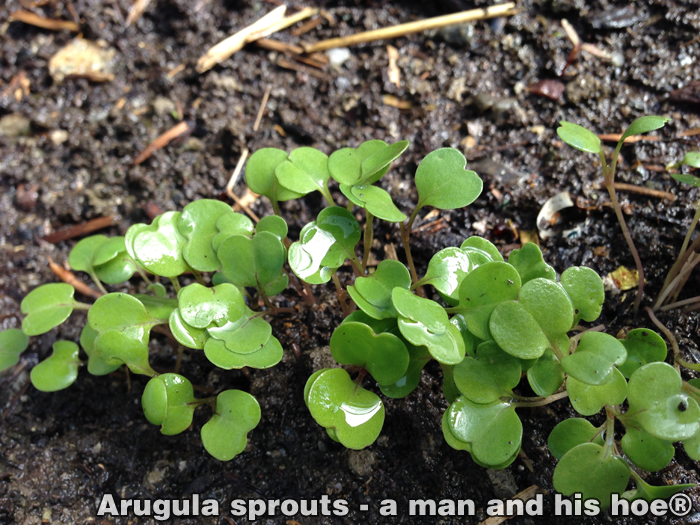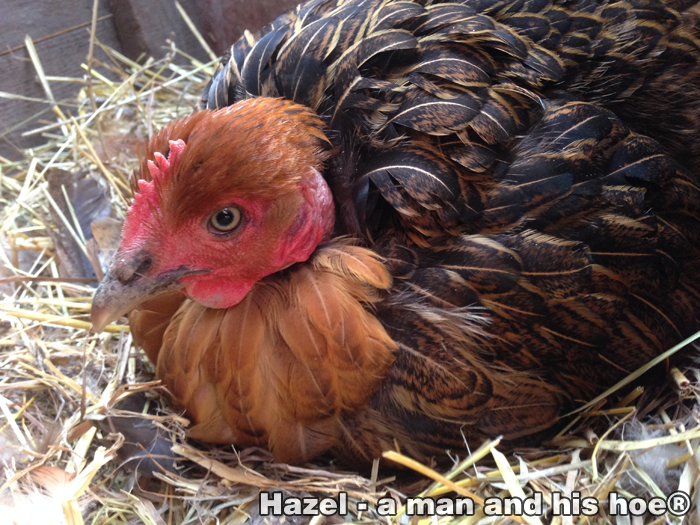

What does a cherry tree full of blossoms look like to a chicken? Manna from heaven? The taste of things to come? Each spring, the chickens enjoy a feast of cherry blossoms. Did the chicken you buy get a chance to taste cherry blossoms? Do the hens which lay the eggs you buy, get to pick fresh fallen cherry blossoms?
[wpvideo dv8XQcha]
All It Takes Is a Little Sunshine

All it takes is a little sunshine to make the cherry blossoms explode. What a pleasant surprise after many days of clouds and rain.

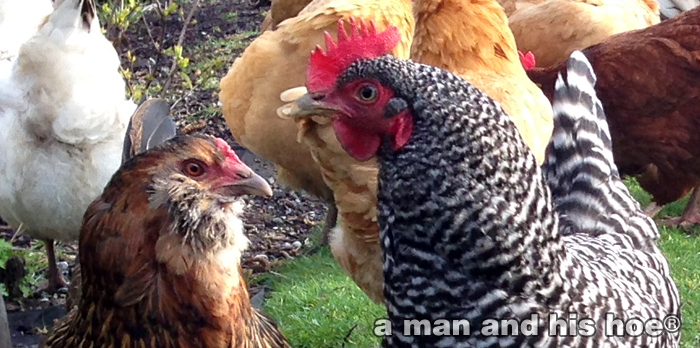
All it takes is a little sunshine to bring out all the chickens. And what are they up to? Are they just out enjoying the late afternoon sun? Are they looking for some treats? Out showing off their Sunday best?

Why Chicks Deserve a Mother – Reason #2
[wpvideo 2kDUb7PB]
Another reason chicks deserve a mother is that with a mother, they get to go outside at a very early age. These chicks are just four days old and they are having the time of their lives scratching around outdoors with their mother. From now on, they will be spending most of their days outdoors. Farmers who raise their chicks without mothers would never consider putting such young chicks out to pasture. Most wait until the chicks are three, four or five weeks old before putting them outside. For example:
- Green Legacy Farms waits until their chicks are four weeks old.
- Jericho Settlers Farm keeps them indoors for three weeks.
- Stony Brook Farm puts them out to pasture after two, three or four weeks depending on the time of year.
- Earth Action Mentor waits three weeks, though if the weather isn’t too cold, they will put them out earlier.
What these farms are doing is understandable. Without a mother to guard and provide warmth as needed, putting chicks outside after just four days would be cruel, if not a death sentence. But with a mother watching over the chicks, going outdoors at just four days old, even in cool weather, is no problem. The earliest I’ve seen a hen take her chicks outdoors is at day two, and the latest at 14 days. Most of the hens have their chicks running around outdoors within a week of hatching.
Why Chicks Deserve a Mother – Reason #1
[wpvideo 3y9aTj4J]
Imelda is curious about the new chicks. The last few days, she’s spent a fair amount of time hanging out with the new mom and her chicks. Is she wanting to hatch eggs of her own? Does she think the chicks look good to eat? I don’t think so because she’s never shown any aggression toward the chicks. She just seems to enjoy hanging out with them.
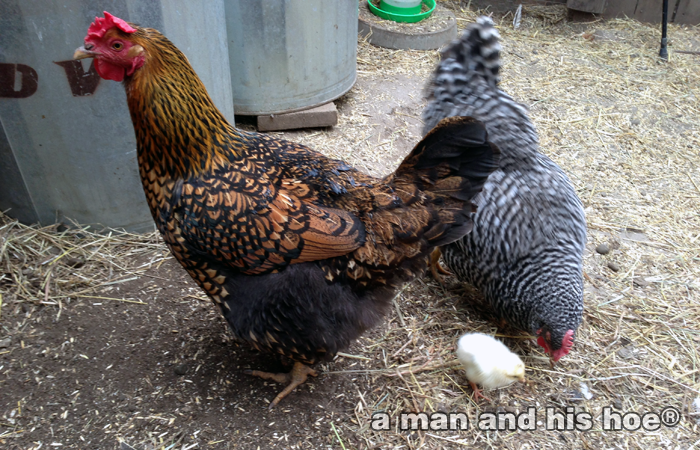
Another Dominique hen has gone broody. Today I prepped an incubation suite for her. She’s been sitting on two wooden eggs for the last two days. Tonight, when it is dark, I’ll move her into the incubation suite and put 10 to 12 eggs under her. Hopefully, in three weeks, I’ll have another clutch of chicks. Moving broody hens is risky. Some will take to the new nest without a hitch. Others will want to go back to the nest where they were brooding.
This is the first time I’ve made an incubation suite. It will give the brooding hen, a safe, quiet place to sit for three weeks without being disturbed by the other hens. Besides having a dark, spacious nest inside the barn, she’ll also have a small yard to eat, poop, and stretch her wings.
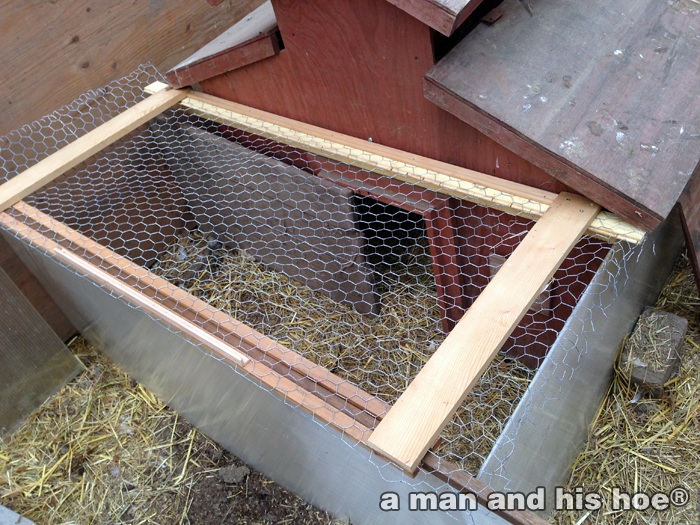
Often, when hens are incubating a clutch of eggs, other hens will insist on laying eggs in the same nest. Some hens stand their ground and won’t budge an inch. However, all brooding hens leave their nest at least once a day to eat and poop. During the twenty to thirty minutes they are off the nest, other hens can hop on the nest to lay an egg. If they are still on the nest when the brooding hen returns, chaos often erupts.
Hopefully, the incubation suite will solve these problems, and give the brooding hen a carefree brooding experience. If she wants to go outside and enjoy a sunbath, I can slide open the side for her and close it while she is out, to keep her eggs undisturbed. Perhaps I should think about temporarily placing a RFID tag on her and wire a door so it would open and shut only for her.
Which brings me to my ultimate dream device: a tiny automated stamping device I could implant in a hen’s vent so that every time she lays an egg, the egg would get a timestamp which includes the hen’s name and GPS coordinates. The device would also have a super fast DNA decoder which would instantly determine which rooster fertilized the egg and stamp his name on the egg as well. Or if the egg was not fertilized, it would note that too. And of course, the device would send a text message with all of this information. Then I would instantly know when and where each hen laid an egg.
More Chicken – The Other Red Meat

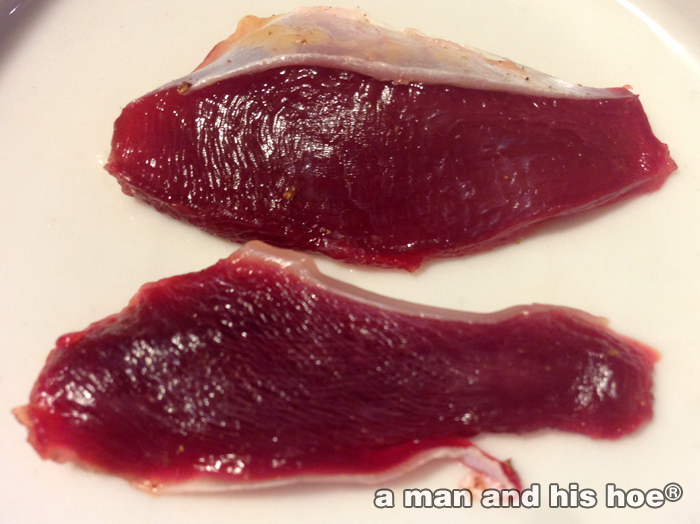
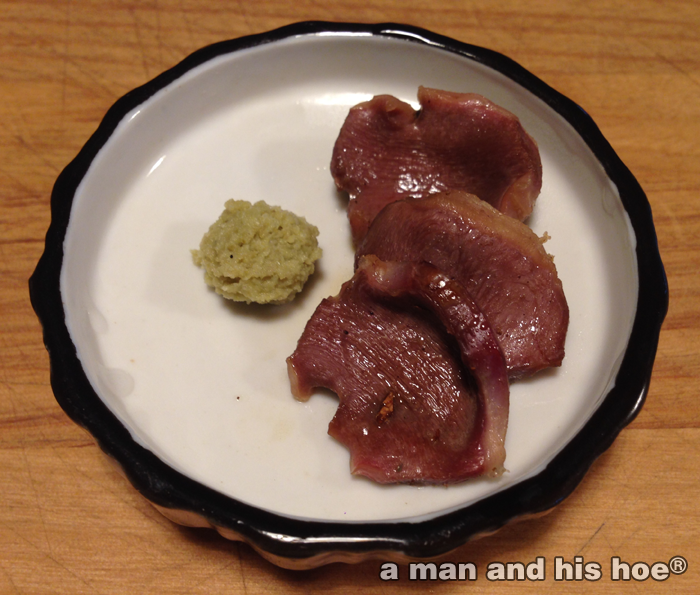
This probably isn’t what comes to mind when you think of chicken. You probably don’t associate such a dark, red meat with chicken. But when roosters get to live outdoors, courting hens through pasture and woodland, breathing fresh air all day, roaming far and wide in search of love, and standing guard over their flock, they develop large, healthy gizzards.
The first time I butchered a rooster, what shocked me was the vibrant colors of his internal organs. Gizzards of healthy, exercising chickens have a beautiful blue hue on the outside. That first rooster’s gizzard was an especially brilliant, cobalt blue.
The gizzard is a strong muscle surrounding a pouch with a tough lining. Inside are bits of gravel and small stones. The food a chicken eats passes into the gizzard from the crop. The muscles of the gizzard churn vigorously, grinding the food and gravel together, turning the grain and grasses and bugs a chicken devours into a mash. The gizzard does the job our teeth do when we chew.
As a result, the gizzard of a healthy chicken is tough. Slice it thin, fry it gently in butter, add some white wine or sake, a bit of soy sauce or Worcestershire sauce, and in a few minutes you have a wonderful appetizer. What makes this meat exceptional is the texture. It has a crunch you don’t associate with meat.
A Very Safe Place

The wonderful thing about letting mothers raise chicks is that you don’t need to keep the chicks under heat lamps. Whenever the chicks need to warm up, they can duck under their mother’s warm feathers for a rest. The other four chicks are in there somewhere.
For a chick, being under a mother’s feathers is a very safe place from which to peek and check out the world.
The Lucky Ones
[wpvideo q93Wl6oJ]
This is a sure sign of spring, the first chicks of the year. They hatched yesterday, and this is their very first morning. These are the lucky ones. The tiny, nearly infinitesimal percentage of chicks born each year which develop in their eggs listening to their mother’s comforting heart beat, which hatch beneath their mother’s warm breasts, and grow up under her tender care.
According to the USDA, in January 2014, 717,153,000 chickens were slaughtered in the USA along, and in February 2014, the number was 675,901,000. None of those chickens had a mother. Neither do the tens of millions of hens which are raised each year by the egg laying business. When you buy my eggs, or my chicken, each one of them was hatched and raised by a caring mother.
Chicken Love – It’s Not Nothing

It’s about her last day brooding. I can hear some of her chicks starting to peep. They start peeping before they hatch so I’m not sure if some have already hatched, or if they are about to. So what drives a hen to sit on a clutch of eggs for three weeks? Is it love? Nothing but instinct? What drives a woman to carry a child to term. Is it love? Nothing but instinct?
Is it just the driving force of hormones? Maybe that’s all love is. What’s in it for the hen? Once the chicks hatch, she will spend one, two, up to three months devoted to them. Then they leave her, she leaves them, either way she doesn’t benefit after that. They don’t dote over her after they are raised. They don’t bring her presents on Mother’s Day or take care of her when she gets old. Since she personally doesn’t benefit, you might say that a hen’s love for her chicks is greater than that of a human’s love for her children. After all, most human parents receive many benefits in return for the love they shower on their children. Many of their children provide plenty of love in return, even caring for their parents as they age. A hen can never count on that.
You need vibrant eggs for a hen to incubate them into chicks. When you buy eggs from a man and his hoe®, you know you are getting very vibrant eggs. My eggs are not dead things. They are very much alive. All it takes is three weeks of gentle heat to turn them into healthy chicks. It’s something we tend not to notice when we buy groceries. Almost all of the things we eat are alive. Any fresh salad is a collection of living plants. If you eat eggs, dairy, or meat, all of those things are the products of living things. And it is love that creates all living things. Love (hormones?) is the driving force which makes things grow and reproduce and grow and reproduce and grow a million, billion, trillion, quadrillion, quintillion, sextillion, septillion, octillion, nonillion, decillion, undecillion, duodecillion, tredecillion, quattuordecillion, quindecillion, sexdecillon, septendecillion, octodecillion, novemdecillion, vigintillion, unvigintillion, duovigintillion, infinite times. (how many?)
Today is the warmest day so far of this year. Many of you may laugh to hear that it isn’t even 60ºF (15.5ºC) yet. But it feels like an early spring heat wave for us. The dogs are loving this warm, sunny day.

Deepening Spring
Spring is deepening day by day. A few more days and the cherries will be in full bloom. Tomorrow, the temperature may even get up to 60ºF (15.5ºC). The last time it was so warm was back on October 27, 2013, nearly five months ago. Wild swings in temperature are rare here. The change from season to season is very gradual. Spring starts to arrive at the end of February here and doesn’t end until mid-July. Summer then makes a short appearance, but my mid-August, you can already feel Fall moving in.
In some ways, this is a great climate for chickens: never too hot, never too cold. Hazel is the perfect example of a happy chicken. She has an uncanny resemblance to Phyllis Diller. Her wild costume and ear-piercing cackle make Hazel the comedian of the flock.
Soufflés Don’t Just Happen
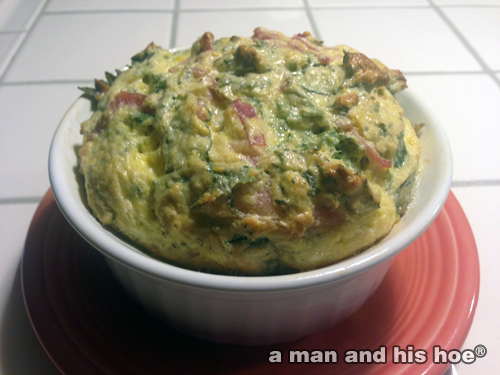
Before you can take a freshly baked soufflé out of the oven you need to pour the soufflé batter into buttered ramekins and put them in the oven.
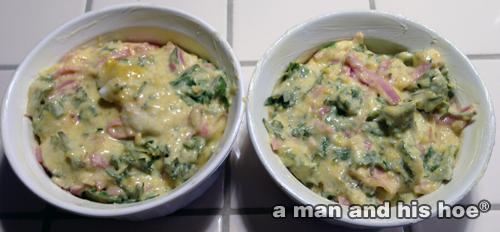
Before you can pour the soufflé batter into buttered ramekins, you need to finish mixing the soufflé batter.

Before you can finish mixing the soufflé batter, you need to add the sliced ham.
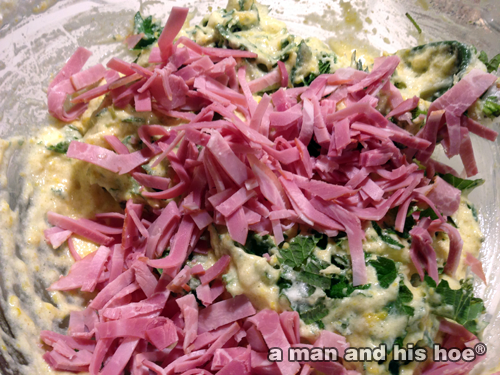
Before you can add the sliced ham to the soufflé batter, you need to finish mixing in the nettle leaves.

Before you can finish mixing in the nettle leaves, you need to add them to the soufflé batter.
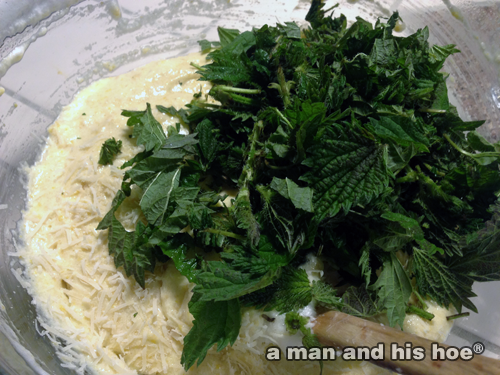
Before you can add the nettle leaves to the soufflé batter, you need to mix in the grated cheese.

Before you mix in the grated cheese, you need to fold in the roux and egg yolk mix into the beaten egg whites
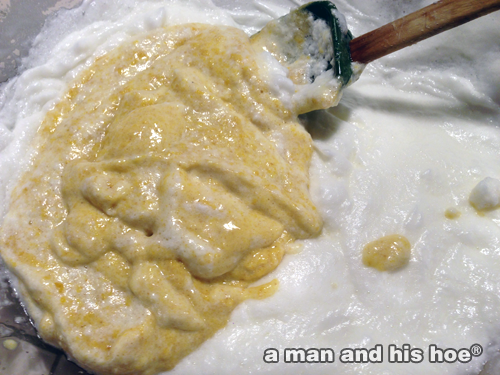
Before you can fold in the roux and egg yolk mix into the beaten egg whites, you need to gently fold in more of the beaten egg whites into the roux.

Before you can fold in more of the beaten egg whites into the roux, you need to add a small portion of the egg whites into the roux and egg yolk mix.

Before you can add a small portion of the egg whites into the roux and egg yolk mix, you need to beat the egg whites into a firm meringue.
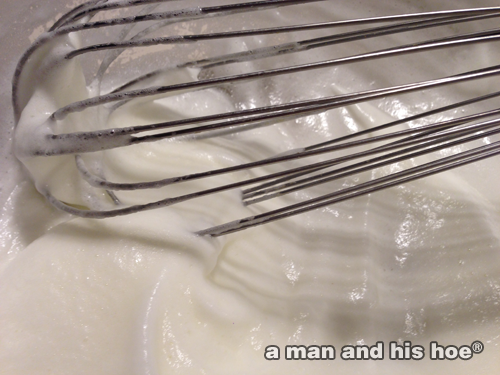
Before you can beat the egg whites into a firm meringue, you need to butter two ramekins.
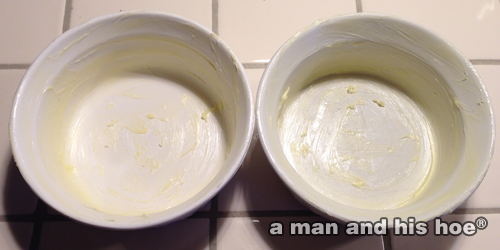
Before you butter two ramekins, it’s a good idea to grate some hard cheese.
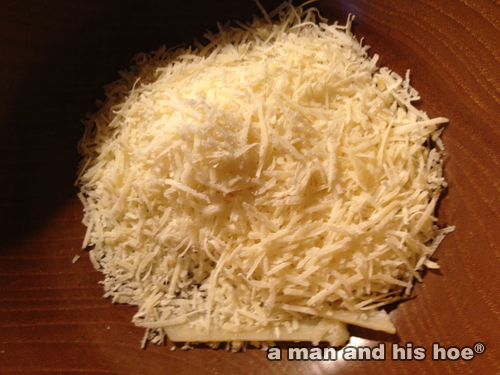
Before you grate some hard cheese, slice some ham.

Before you slice some ham, cut the nettle leaves.
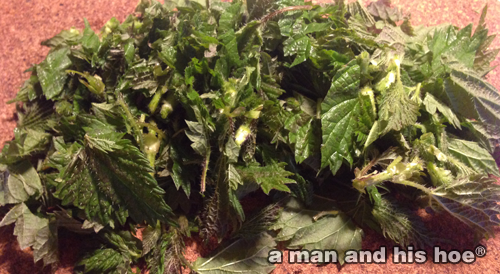
Before you cut the nettle leaves, finish making your rough and egg yolk mix.
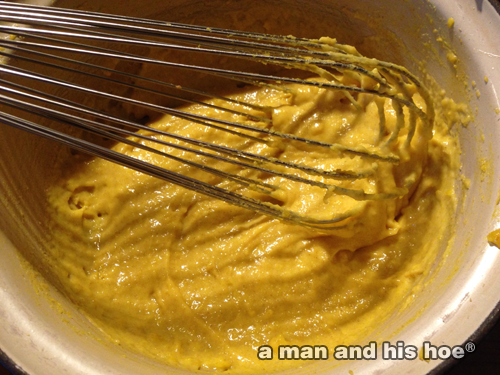
Before you finish making your rough and egg yolk mix, take the rough off the stove and quickly beat in the egg yolks with some milk.

Before you take the rough off the stove and quickly beat in the egg yolks with some milk, cook the rough until it gathers into a soft ball.
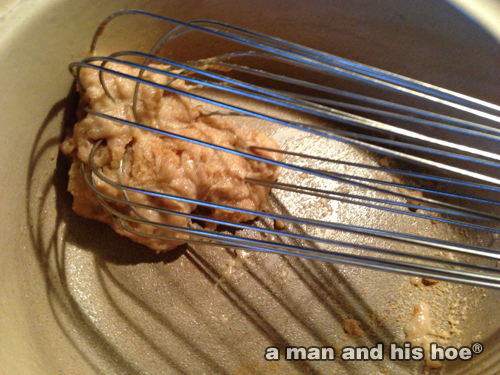
Before you cook the rough until it gathers into a soft ball, brown the flour and butter together.
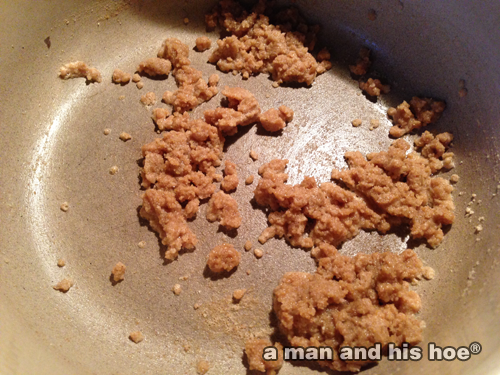
Before you brown the flour and butter together, melt some butter in a pan and add some flour.

Before you melt some butter in a pan and add some flour, wash the freshly picked nettles.

Before you wash the freshly picked nettles, you’ll need to go out into your garden and pick them. You don’t have nettles in your garden? That’s OK, you can use any fresh greens that you find in your garden. Oh, you don’t have a garden? You can’t just go outside and gather something fresh to eat? I guess you could run down to your local green grocer and ask if they have any produce that was picked with the last few hours. What? Your grocer doesn’t even have anything picked today? How is that possible? Surely there is a farm within a 30 to 60 minute drive from your green grocer. There’s no excuse not to have fresh produce picked at least that morning. Well, just do your best, and if your green grocer doesn’t have produce picked that day on their shelves, it’s time to find a new green grocer or find a nearby farmer who will see that you have produce picked that day.

Before you wash you go pick your fresh nettles or greens, break your eggs and separate the egg whites from the yolks.
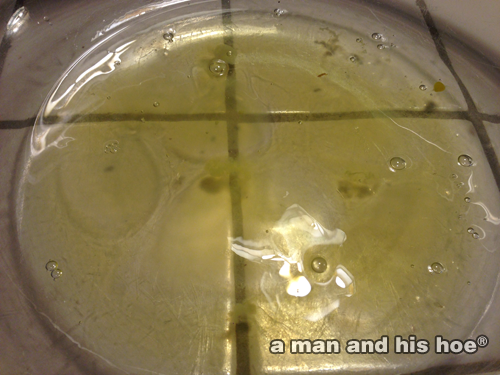

Before you break and separate your eggs, select five eggs laid today. Five eggs will make two individual soufflés. If you have more people, figure between two and three eggs per person. Eggs work best at room temperature, so if your eggs are in the refrigerator, take them out and let them rest until they are at room temperature.
You don’t have eggs laid today? When were the eggs you have laid? What? You don’t know? Don’t tell me you purchased eggs which you didn’t know how old they were? Didn’t the farmer who sold you your eggs tell you when they were laid? Oh, you forgot to ask? Or did you say you bought your eggs from a supermarket? You can’t see a label on the carton saying how old they are? I wonder why that is? What are they trying to hide? Maybe it’s time to raise your egg standards. The next time you purchase eggs, ask the seller you’d like eggs laid that day. If they look at you like you’re nuts, take a deep breath. You’re not the crazy one. The seller who thinks it doesn’t matter how old eggs are to make a good soufflé is the crazy one.

Life is too short for ho-hum eggs. Find someone who will sell you fresh eggs from chickens that spend all day outdoors enjoying the fresh air, sunshine, and exercise.

